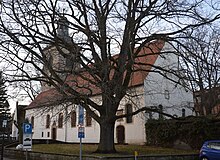Ummendorf village church
The village church Ummendorf is the Protestant church in Ummendorf (Börde) in Saxony-Anhalt .
It is located on Gutsstraße in the center of Ummendorf.
Architecture and history
The oldest part of the church are the lower floors of the tower, which date back to the beginning of the 13th century. The tower area and the church hall to the east of it, laid out on a rectangular floor plan, have the same width. In the middle of the 16th century, the lord of the castle, Andreas von Meyendorf, and the pastor at the time, Wolfgang Kropf, introduced the Reformation to the parish . The current appearance of the church was created in particular through extensive renovations in the years from 1556 to 1566. Both the church tower and the nave were widened to the south. At the same time, the walls of the ship were raised. The keel arched windows on the north side were also built during this period . The arched curtain window on the east side, now walled up, is dated to 1556. On the south side there are two portals made of sandstone . The west of the portals is designed in the form of a segmented arch and is provided with a narrow frame made of frameworks . Above the portal, dated 1562, is a depiction of the risen Christ as the victor over death and the devil . The portal to the east of this has a keel arch and was built in 1566. It is provided with an inscription panel above, which refers to a further redesign of the church in 1696. The windows on the south side have a flat arch and probably date from 1696. Before that, the church was badly damaged during the Thirty Years War and no services were held in it for several decades. The reconstruction of 1696 was arranged by the bailiff Johann Christopf Pflüger . The wall paintings that were made at that time are now partially hidden under later paintwork.
In 1713, today's bell storey of the tower as well as the hood and lantern were added.
In 1905 the church was restored. During a storm in the 1980s, the top of the tower was snapped off. In the 1990s, the church roof was re-roofed and the crowning of the tower was repaired, including a cross. The letters JCP can be read in the weather vane . They are reminiscent of Johan Christopf Pflüger , who had the original tower hood put on. The sandstone frames of the windows have also been restored or renewed.
In the local register of monuments , the church is listed as an architectural monument under registration number 094 11987 .
Furnishing
The interior of the church is spanned by a flat wooden barrel ceiling. Galleries have been added on the north and west sides . They are decorated with parapet paintings with representations from the Old and New Testament from 1697. The carved supports that exist here are presumably older.
The altarpiece, which is described as being of good quality, dates from around 1580. On the back there is an inscription mentioning the year 1588, but classified as doubtful. resembles that of the Sankt-Stephanus-Kirche in Schermcke . In the middle it shows a large painting depicting the resurrection, which may have been created by Adam Offinger . In the niches arranged at the side there are sculptures depicting justice and hope. These include baroque paintings depicting the crucifixion and the Lord's Supper. The frame is splendidly carved and richly decorated with fittings , heads, fruit pendants and figures.
The pulpit is also richly carved and decorated with acanthus and fruit hangings. The parapet figures depicting Moses and the evangelists have been partially renewed.
The font dates from 1826. In addition, there is the sandstone basin of a font from the beginning of the 13th century. It is believed that this piece still comes from the village church of the now desolate town of Selschen .
In the east wall of the church there are two stained glass windows. They were created in 1901/02 by the Franke company and show scenes from the life of Jesus. The organ was created by the Dinse brothers from Berlin in 1912 and came to Ummendorf in 1928 through a purchase from the Berlin Johanniskirche. The church has two bronze bells from the 14th and 16th centuries.
In the church there are various tombstones of the von Meyendorf family from the period between 1548 and 1598. They show the deceased as relief figures. Below the choir there is a baroque tomb . In the crypt is one of sandstone manufactured sarcophagus with lavish decorations. It was created for Anna Maria Pflüger , née von Landsberge , who died in 1713 , and was found during the restoration work in 1905.
In the 1960s, parts of the interior were changed.
Rectory and Luther Hall
The rectory dates from 1745. In the 1930s, the old parish barn was converted into the Luther Hall , which is used for community events and church services in winter.
literature
- Ute Bednarz: Dehio, Handbook of German Art Monuments , Saxony-Anhalt I, Magdeburg administrative district . Deutscher Kunstverlag , Munich / Berlin 2002, ISBN 3-422-03069-7 , p. 951 f .
Web links
Individual evidence
- ↑ Short question and answer Olaf Meister (Bündnis 90 / Die Grünen), Prof. Dr. Claudia Dalbert (Bündnis 90 / Die Grünen), Ministry of Culture March 19, 2015 Printed matter 6/3905 (KA 6/8670) List of monuments Saxony-Anhalt , page 490
Coordinates: 52 ° 9 ′ 21.4 ″ N , 11 ° 10 ′ 55 ″ E
